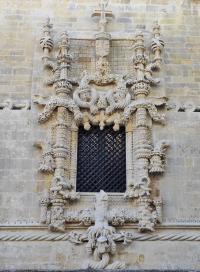- HOME
- MONUMENT
- Convent of Christ
- History
- Architecture
- Personalities
- King Afonso Henriques
- D. Gualdim Pais
- King Dinis
- King John I
- D. Lopo Dias de Sousa
- King Duarte
- Prince D. Henrique (Henry
- King John II (1455 - 1495
- King Manuel I (1469 - 152
- Diogo de Arruda
- João de Castilho
- Jorge Afonso
- Olivier de Gand
- King John III (1502 - 155
- Diogo de Torralva
- Friar Anthony of Lisbon
- Baltazar de Faria
- Filipe Terzi
- Philippine Dinasty
- King Philip II of Spain
- King John IV
- Domingos Serrão
- Queen Mary II
- Prince Fernando
- Costa Cabral
- Artisans and Artists
- Intangible Heritage
- Related Heritage
- Glossary
- VISIT OUR MONUMENT
- HERITAGE LEARNING
- TOMAR
- MONASTERIES ROUTE

Monosteries Route
Route Through World Heritage Portuguese Monasteries.
Three outstanding monuments inscribed on UNESCO's World Heritage List and defining the most important monastic triangle in Portugal's Centre region have come together to form the ROUTE THROUGH WORLD HERITAGE PORTUGUESE MONASTERIES - the Monastery of Alcobaça, Monastery of Batalha and the Convent of Christ.
The ROUTE THROUGH WORLD HERITAGE PORTUGUESE MONASTERIES has been devised by IGESPAR as an integrated management project for 3 major Centre region cultural resources under its care, in liaison with the Monastery of Jerónimos, in Lisbon. The objective is to explore their potential so as to provide an answer to the role heritage represents to society today.
These monumental complexes of major historical and architectural value, at a national and international scale, are located in a privileged landscape area, next to other poles of interest such as the Fátima Sanctuary and the Natural Park of Serra de Aire and Candeeiros. Besides, there is a large area of diffuse heritage that is, either through history, theme or geography, linked to the main monumental complexes.
The 3 key themes associated to the 3 monumental complexes - the ORDER OF CISTER (Monastery of Alcobaça), the BATTLE FIELDS (Monastery of Batalha) and the TEMPLARS (Convent of Christ) complement each other for a better understanding of the origin and development, not only of that particular area, but also of the whole country. This is why they are the subject of an in-depth study in this Route.
PORTUGUESE DISCOVERIES complement this perspective and this is where the Monastery of Jerónimos (Lisbon) comes in. It also has a connection to this ROUTE, as far as the forthcoming cultural agenda for these 4 monuments is concerned.
Against this background, the IGESPAR, together with the municipalities of Alcobaça, Batalha and Tomar, submitted a joint application called the Strategic Programme - ROUTE THROUGH WORLD HERITAGE MONASTERIES to the Centre Region Operational Programme, Axis 2, "Development of Cities and Urban Systems", within the intervention area known as City Policy - urban networks for competitiveness and innovation, as a beneficiary partner.
This application, that has been approved, involves a total investment of 15.384.614,00 Euros, of which 14.923.076,00 Euros are eligible (contribution of 65% from MaisCentro, 8.099.999,05 and from PORLisboa 1.600.000,35) to be distributed between 2009 and 2012).
The Strategic Programme has 6 different categories (Identity, Attractiveness, Receptivity, Interactivity, Visibility and Continuity/Quality) and is subdivided into 9 Intervention Lines (1. upgrade of symbolic public areas; 2. promotion of emblematic events and animation of cities as cultural attractions; 3. heritage brought to life and upgrading of cultural equipment; 4. creation of visiting and interpreting routes, 5. reception of visitors, 6. improvement of tourism services; 7. city network digital platform for tourism; 8. marketing, promotion and communication; 9. interurban cooperation mission extending to the World Heritage Portuguese Monasteries.
The IGESPAR is the leading partner of three different projects:
-Programming the annual agenda of city network cultural activities based on the monasteries;
-Establishing group visit programmes and producing historical interpretation contents;
-Promoting scientific annual meetings on each monastery focusing on its specificity. Apart from the 3 promoting municipalities, this project is also supported by the municipality of Lisbon, the Directorate General for the Arts and the Museums and Conservation Institute.
Besides, the IGESPAR also submitted the "Route through Portuguese Centre Region World Heritage Monuments", to the Centre Region Operational Programme, Priority Axis III, Consolidation and Upgrading of Sub-regional Areas, Cultural Heritage Specific Regulations, within the QREN (National Strategic Reference Framework). This Project also provides conditions for improving and enhancing the conditions of fruition, while also safeguarding and preserving the monuments involved, as well as their surroundings. Risk prevention and safety measures have also been provided for.
SERVICES - ACTIVITIES




